Dogs are man’s best friend; however, sometimes that friend turns into a violent offender armed with razor-sharp teeth and a mean attitude!
All dogs can and will bite if forced to, but some dangerous dog breeds are more willing to give you a personal demonstration of the dark side of dog ownership.
The 13 most dangerous and banned dog breeds that you should know are:
- Pitbull
- Fila Brasileiro
- Dogo Argentina
- Japanese Tosa
- Akita
- Doberman Pinscher
- English Boxer
- Chow Chow
- Wolf Hybrid
- Bull Mastiff
- German Shepherd
- Siberian Husky
- Rottweiler
Most dog lovers rebel against the thought of labeling any dog breed dangerous, but the reality remains that some breeds have a greater capacity for harm than others.
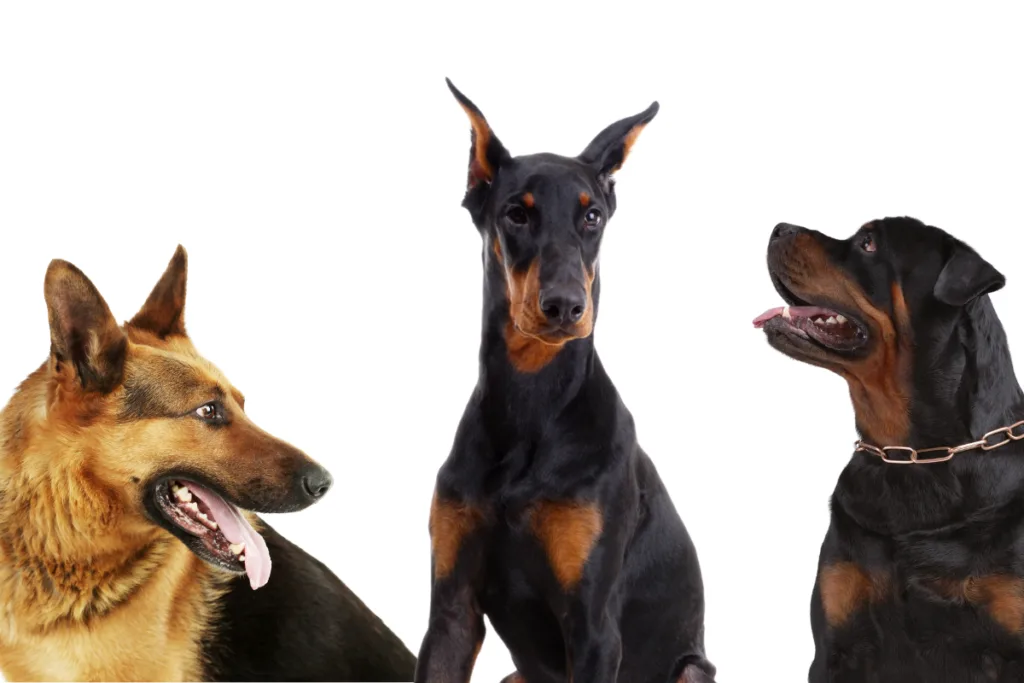
The dog breeds listed in this article have been consistently involved in fatal or near-fatal attacks. As a result, many governments and local authorities have banned or restricted ownership of these dangerous dog breeds.
Click Here to Jump to a Section
The 4 Most Commonly Banned Dangerous Dog Breeds
The “Dangerous Dog” act passed in the United Kingdom in 1991 prohibited the ownership, breeding, and trade of four dangerous dog breeds.
These dogs were identified as significant threats to public safety, and it was made a criminal offense to own and work with these dogs in any capacity.
Subsequently, numerous countries followed the UK’s example and developed breed-specific legislation outlawing specific dog breeds.
The four dogs breed banned in the UK, and many other countries are:
- The Pitbull
- The Fila Brasileiro
- The Dogo Argentino
- The Japanese Tosa
Although these breeds are not illegal to own in the USA, certain states, cities, and counties regulate ownership of these dogs.
1. The Pitbull
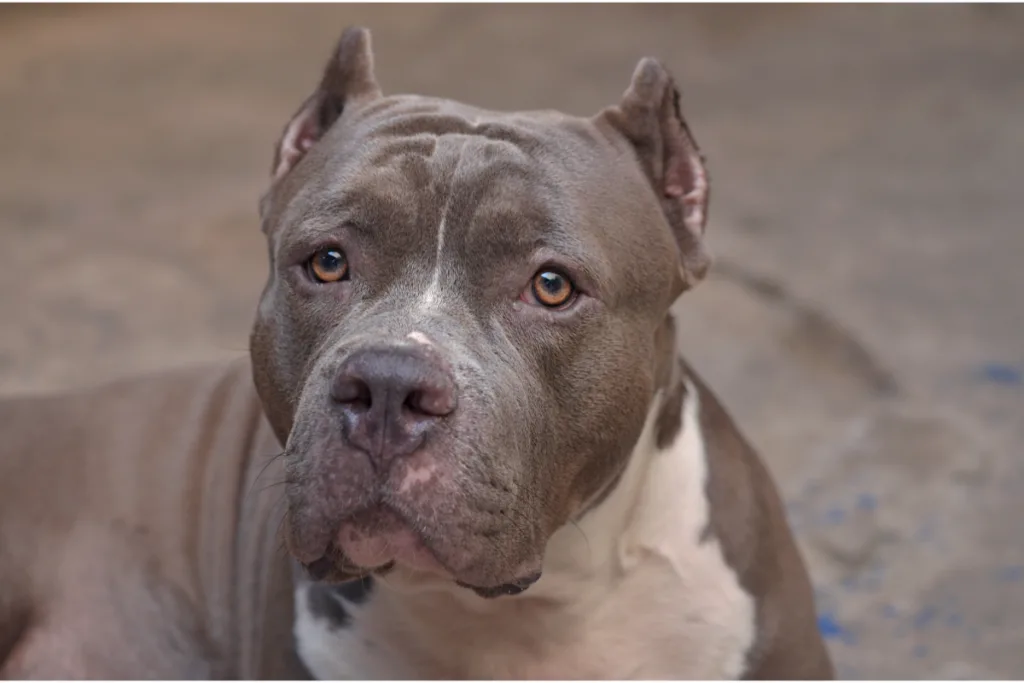
Many people are surprised the learn that the term “pitbull” does not refer to a specific dog breed but rather a type of fighting dog.
Breeds described as a pitbull-type include the American Bully, American Staffordshire Terrier, American Pit Bull Terrier, Staffordshire Bull Terrier, and the American Bulldog.
Pitbulls have had a tumultuous history with humans, and there is much to be forgiven for the role humans have played in this breed’s downfall.
The History Of Pitbulls
In the 1800s, UK-bred Pitbulls were used in cruel and inhumane blood sports, where dogs were pitted against bears and bulls to entertain the crowds.
The dogs were encouraged to attack these dangerously traumatized animals until the animal collapsed from fatigue and injuries.
In 1835, the British authorities passed the “Cruelty to Animal” act, outlawing bear and bull baiting. However, the bloodthirsty humans were more intent upon entertainment than compassion towards animals.
Instead of bulls and bears, they set their dogs to catching trapped rats and eventually to fighting one another. The act passed in 1835 to protect animals inadvertently led to the advent of underground dogfighting.
Nonetheless, these fighting dogs were still bred to be loyal and safe companions to their human owners; dogs who bit humans were immediately destroyed.
Eventually, the staunchly loyal Pitbull made its way to America, where it quickly found its place amongst the American working class.
It was considered an icon of the friendly, brave, hardworking, loyal Americans; Americans so thoroughly loved these dogs that the UK-bred pitbull was renamed the American Pit Bull Terrier.
The beloved pitbull further endeared itself to the public with its heroic services during WWI and WWII.
In 1976, the American Congress amended the “Animal Welfare” Act to prohibit purposeful dogfighting. Sadly, this did not stop dogfighting as a sport.
Animal rights groups noticed increased ownership of Pitbulls by known criminals. These unsavory individuals used their dogs for dogfighting, personal protection, and intimidation; they actively bred unstable and aggressive Pitbulls with little to no bite inhibition.
Public regard for the pitbull rapidly dropped until they were regarded with fear and hatred. Until recently, most rescued or seized Pitbulls were euthanized as standard procedure regardless of the individual’s temperament.
You may also be interested in:
German Shepherd Pitbull Mix: All You Need to Know
Fatalities And Bite Strength Of Pitbulls
Between 2005 and 2018, 433 Americans were killed by dogs; of these deaths, 66% involved Pitbulls.
The most vulnerable demographic was children; Pitbulls are capable of an impressive bite force of 235 PSI, and thus one bite can be lethal to a small child.
In 2018, America’s Veterinary Association estimated that Americans owned 76,811,305 domestic dogs, with Pitbulls accounting for 6.5% (4,992,734 dogs); during this period, Pitbulls were involved in 26 fatal attacks on humans.
These statistics indicate that each Pitbull has a 0,00052% chance of being involved in a fatal attack.
The bite statistics do not describe the circumstances surrounding the attacks. Thus the danger may be lower if the pitbull is wellbred and handled by experienced, safety-conscious dog trainers.
2. The Fila Brasileiro
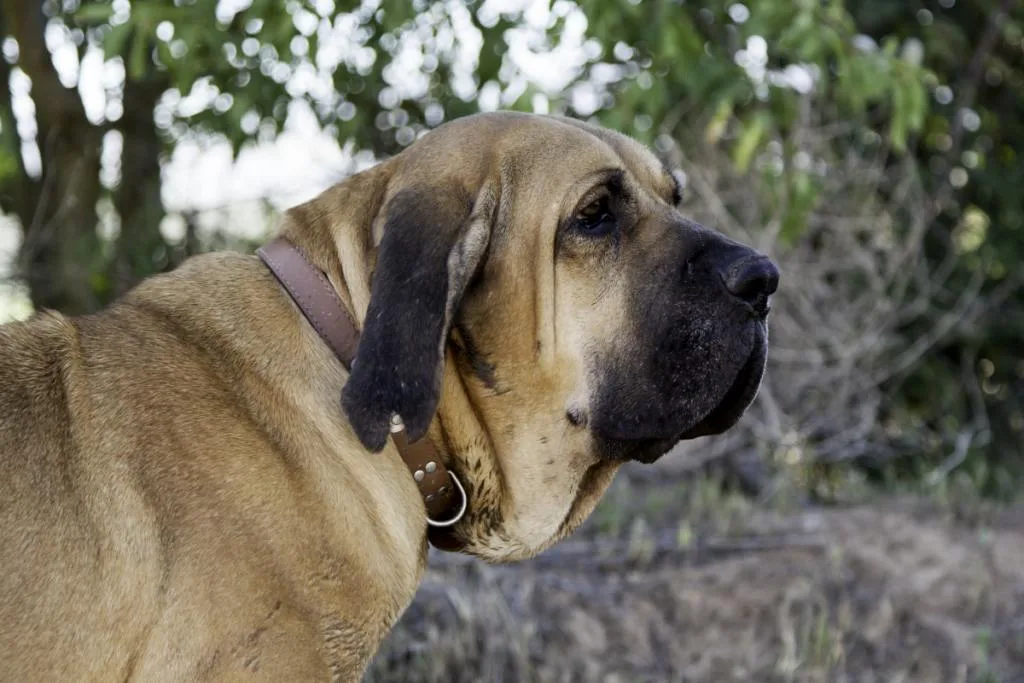
The Fila Brasileiro is a livestock guardian who has been banned in the UK, Denmark, Norway, Malta, Cyprus, and many states, including Wisconsin, Washington, Oregon, Kansas, and Colorado.
This breed is certainly large enough to inflict harm if they wish to; they typically weigh between 110 to 180 lbs and stand 25” to 30” at the shoulder.
This breed was initially bred to be a livestock guardian. The dogs are fiercely loyal and devoted to their families but have a reputation for extreme aggression towards strangers and a dominant, stubborn attitude towards training.
The Fila Brasileiro is recognized by the International Canine Federation, although the American Kennel Club has not added the Fila Brasileiro to its list of established dog breeds.
The Fila Brasileiro remains a relatively rare dog amongst the American population, thus reported attacks are few and far between.
The Fila Brasileiro needs a confident, experienced handler who is strong enough to cope with the physicality of these powerful dogs.
You may also be interested in:
Are German Shepherds Good Livestock Guardians? All You Need to Know
3. Japanese Tosa
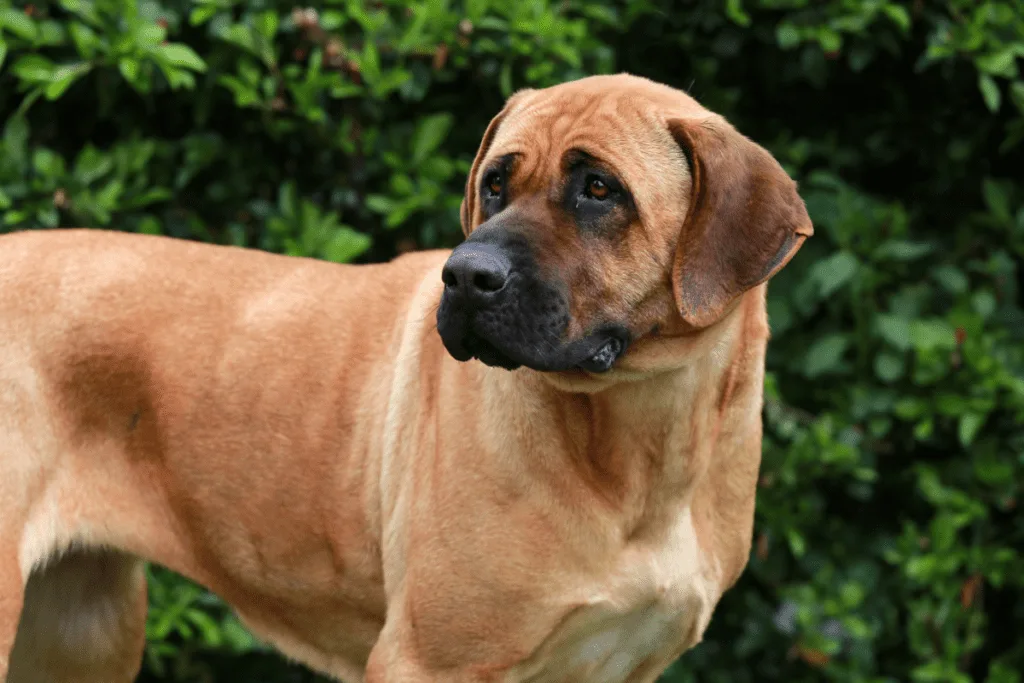
This breed of dog is enormous; they’re not overly tall, standing at 21.5″ to 23.5″, but they are HEAVY! It is not uncommon to find the Japanese Tosa weighing in at an excess of 200lbs!
Unfortunately, there is no way to make their history more palatable; unlike many other dog breeds which performed another function and then switched to dogfighting, this breed was developed as a dogfighter.
The Japanese Tosa was developed by crossing the native dogfighting champion, the Shikoku Inu, with western-bred Bull Mastiffs, Bulldogs, and Great Danes.
It is clear from the breeds used in developing the breed that aggression and size have always been the main priority.
Surprisingly, the AKC describes the breed as patient and not overly aggressive to humans. However, the breed is highly dog aggressive and cannot be trusted around dogs or small animals.
Japanese Tosa are aloof around strangers and should not be left unattended when visitors arrive at their homes.
Ideally, for the safety of the dog and house occupants, the Japanese Tosa needs to be confined to a room or the garden during social gatherings.
The most dangerous aspect of the Japanese Tosa lies in their commitment to a fight and their large size. A Japanese Tosa may not always be the dog that starts a fight, but they are guaranteed to end it!
The Japanese Tosa’s large size and heavy, muscular build make it almost impossible to pull a fighting Japanese Tosa off its victim once they get going.
Ownership of a Japanese Tosa is either illegal or restricted nationally in more than 16 countries.
4. Dogo Argentino
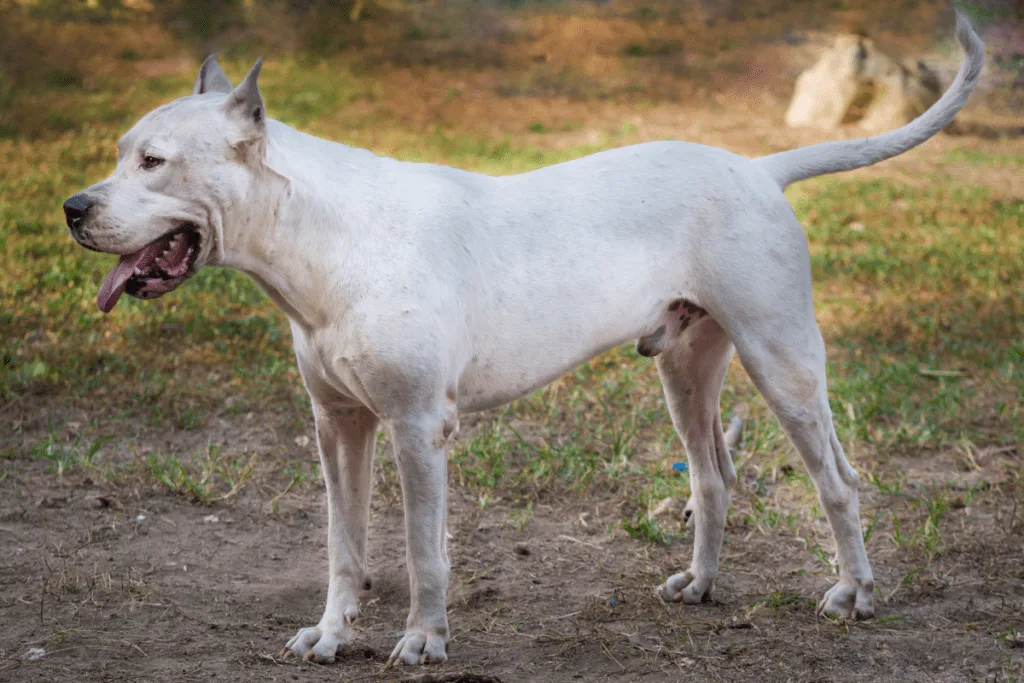
The Dogo Argentino is considerably smaller than the Japanese Tosa and Fila Brasileiro.
The breed typically is between 24 and 26.5” tall and 80lbs to 100lbs. While taller than the two breeds mentioned earlier, they are significantly lighter, weighing approximately 50% of those heavyweight breeds.
However, don’t let the Dogo Argentino’s lighter weight fool you; these muscle-bound athletes are not to be taken lightly! The breed was created by Dr. Nores Martinez, an Argentinian doctor, for big game hunting and dogfighting.
Specific large breed dogs were crossed with the original fighting dog of Cordoba to create a tenacious, fearless dog capable of extreme acts of aggression.
The Dogo Argentino was known as a specialist puma, wild boar, and peccaries hunter, i.e., the more dangerous the prey, the better the Dogo Argentino performed.
While the AKC scores this breed as moderately good with other dogs and children, they strongly emphasize that it is unsuitable for novice dog owners.
Dogo Argentino owners need to be physically strong, confident, consistent, and experienced dog handlers. This breed is not an add-on to your life; to responsibly handle this breed, you need to build your life around the dog!
A well-bred Dogo Argentino can be an excellent addition to the household if handled by an experienced owner. However, when placed in the wrong home, this dog is a high-powered, often lethal animal.
Dogo Argentinos are responsible for one fatal dog attack in Maryland, USA, in 2018, when a breeding pair killed their owner. Despite their rarity, Dogo Argentinos are involved in a relatively high incidence of bite injuries.
Ownership and trade of Dogo Argentinos are illegal in more than 10 countries, including the UK.
Dogo Argentinos have not been banned in the USA on a national or state level; however, they are a regulated breed in New York City, Aurora (Colorado), and Livingston County (Michigan).
10 Popular American Dogs Who Are Considered Dangerous
The following is a table of the 10 most popular dog breeds involved in human fatalities, and maiming’s in the USA between 1982 and 2021. The majority of these dogs are excluded by most, if not all, of the homeowner insurance companies.
| Dog Breed | Fatalities (1982 to 2021) | Maimings (1982 to 2021) | Excluded From Home Owner Insurance | AKC Popularity Rank (2020) |
| Akita | 8 | 57 | 79% | 48 |
| Doberman Pinscher | 8 | 19 | 100% | 18 |
| English Boxer | 10 | 45 | 10% | 11 |
| Chow Chow | 10 | 60 | 95% | 84 |
| Wolf Hybrid | 19 | 52 | 93% | Not recognized |
| Bull Mastiff | 20 | 72 | 24% | 55 |
| German Shepherd | 26 | 137 | 29% | 3 |
| Siberian Husky | 30 | 37 | 38% | 16 |
| Rottweiler | 92 | 346 | 100% | 8 |
| Pitbull | 356 | 3086 | 100% | Not recognized |
You may also be interested in:
Do German Shepherds Increase Homeowners Insurance?
What Makes A Dog Dangerous?
Not all dogs are dangerous; for a dog to be classified as dangerous, they need to answer yes to the following questions:
- Can the dog cause harm?
- Is the dog willing to cause harm?
- Is the dog uncontrollable?
Can The Dog Cause Harm?
The ability to cause harm is perhaps the most apparent reason to classify a dog as dangerous or not dangerous.
Small dogs like chihuahuas are characterized by a napoleon complex that often sees them placed at the top of a leader board for aggression and non-fatal dog bites.
However, the damage inflicted by these tiny terrors is rarely significant and certainly not fatal!
Large and giant breed dogs are significantly more capable of inflicting severe injury during a fight; they have the strength and physicality needed to overpower most children and small or physically weak adults.
When considering the danger factor of a dog, it is essential to consider its size, jaw conformation, and bite strength.
Heavily muscled Mastiffs can bite down with an impressive amount of force, whereas slender jawed Greyhounds and Afghans cannot hope to replicate a mastiff’s bite force.
However, just because a dog can cause harm does not mean it will, which is the premise underpinning the next question.
Take a look at the video below, as it has some great clips of these dogs in action – you can see for yourself why these breeds have made our list!
Is The Dog Willing To Cause Harm?
Dogs like Newfoundlands and Bernese Mountain Dogs are heavy-set, muscular giant breeds dogs; however, they are not classified as dangerous.
These dogs are renowned for their mild-mannered, stable approach to life, which is often lacking in dangerous dog breeds.
Dogs bred as territorial guardians, livestock guardians, or hunters have been selectively bred for increased aggression. These dogs are often prized for their:
- Dominance
- Prey drive, i.e., their instinct to hunt and kill
- Resilience and pain tolerance; a dog who retreated when hurt is of little value to owners breeding dogs for aggression-reliant functions, e.g., protection or hunting
- Gameness, i.e., the willingness to enter into and continue to fight even in the face of overwhelming odds
- Poor sociability, e.g., a watchdog who makes friends with strangers, is not a good property defender. However, a dog who hates all strangers will be prized for its exemplary performance as a protective dog.
Is The Dog Controllable?
The last factor to consider is how controllable the dog is. Aggression is not always a negative or unwanted trait; if it were, these dog breeds would have gone extinct a long time ago.
Dogs who can inflict physical damage and are willing to do so but are reliably obedient are considered safer than dogs who are willful, unpredictable, or difficult to train.
For example, The US police have successfully utilized aggressive dogs as a non-lethal means of stopping violent offenders; however, these dogs are not considered dangerous as long as they remain obedient to their handler and only show aggression when commanded.
The second factor that increases the danger level of dogs is predictability. For example, if you know your dog is food aggressive, you can take steps to avoid triggering their aggression.
However, it is impossible to take proactive steps to ensure the safety of everyone involved if the dog is unpredictably aggressive.
Controversy Surrounding The “Dangerous” Dog Breeds
This article is all about dangerous dog breeds; however, there is significant controversy surrounding the practice of labeling an entire dog breed as dangerous.
Many animal rights activists claim that you cannot judge a dog’s danger rating based on a breed, and thus arbitrarily banning an entire dog breed does not increase public safety.
For example, many Pitbull owners (a so-called dangerous breed) adore their Pitbulls for their clownish, good-humored approach to life.
In contrast, Labradors, America’s favorite family dog, have been involved in 9 fatal dog attacks over a 13 year period.
Whether a breed or individual dog is dangerous is not straightforward; it is a complex classification based on many different inter-linked variables.
However, the breeds listed here are known for increased levels of aggression and have been implicated in fatal dog attacks.
You may also be interested in:
What’s the Bite Force of a German Shepherd?
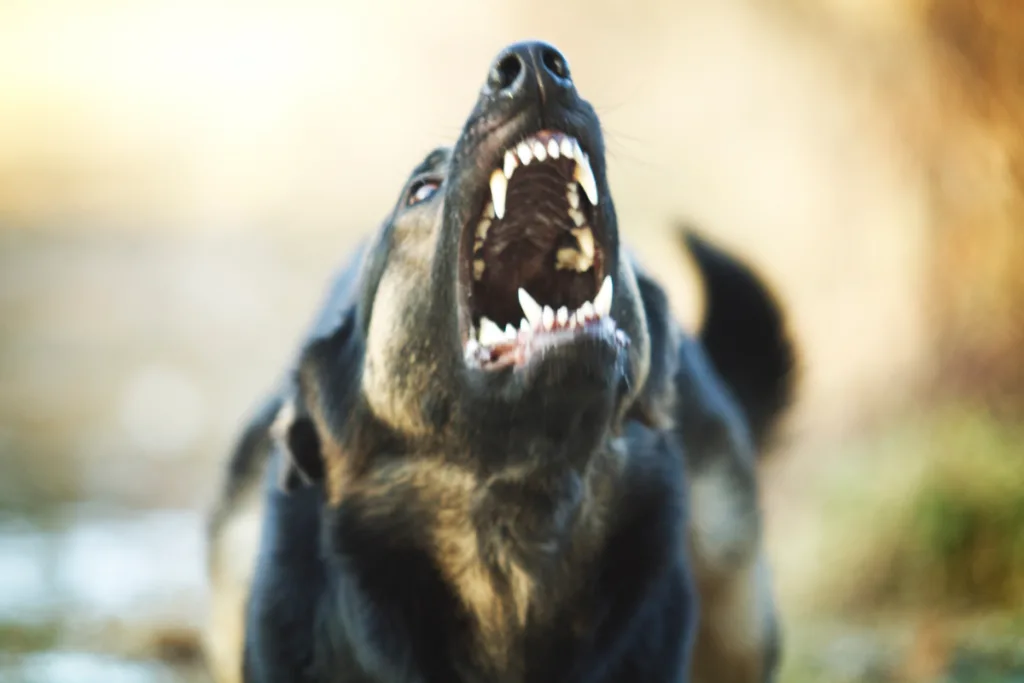
Final Thoughts
It is difficult to rationalize how an entire dog breed can be labeled as dangerous and thus illegal to own.
However, the reality remains that the dogs listed here have been bred for extreme aggression and the damage they can inflict is significant and sometimes even fatal.
Unless competent, safety-conscious owners manage these breeds, they will continue to earn their dangerous reputation.
